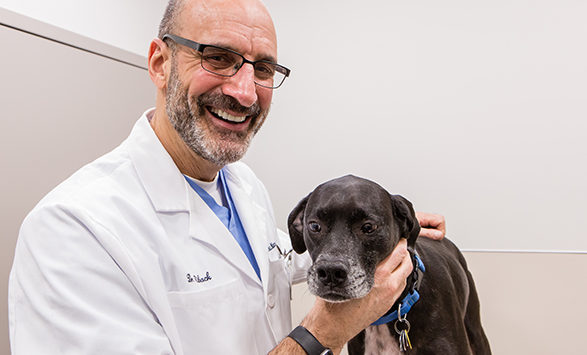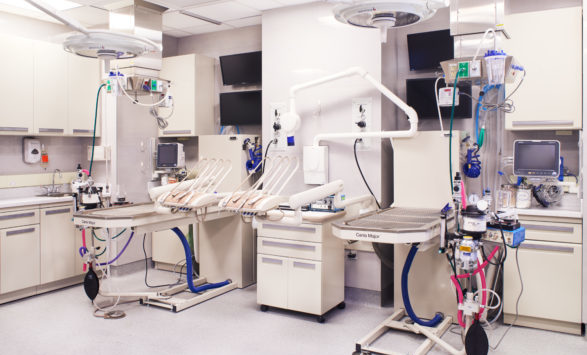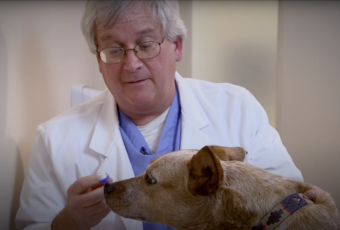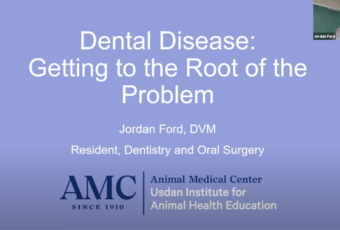Periodontal Disease in Dogs
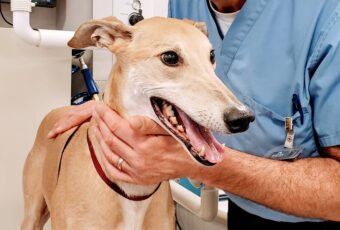
Background
Periodontal disease (gum disease) is one of the most common diseases found in dogs. More than 80 percent of dogs show early stages of the disease by the time they are 3 years old. Periodontal disease is caused by plaque bacteria, and the immune system’s destructive reaction to it. Without regular cleaning, dental plaque accumulates and becomes mineralized, forming dental calculus or tartar. Once it has mineralized, dental calculus becomes much more difficult to remove.
Periodontal disease ultimately causes damage to teeth and their underlying supportive structures (i.e., gingiva, bone, ligaments). Early detection and treatment are critical because advanced periodontal disease can cause pain, loss of teeth, and even jaw fractures.
Periodontal disease can also impact systemic health. It can make dogs more likely to develop diseases of other organs, including the heart, lungs, kidneys, and liver, and it can make other disease processes like diabetes more difficult to control.
Risk Factors
Small breed dogs and those with short muzzles are more prone to periodontal disease due to the overcrowding and misalignment of teeth in their mouths. However, all dogs are at risk for developing periodontal disease in their lifetime.
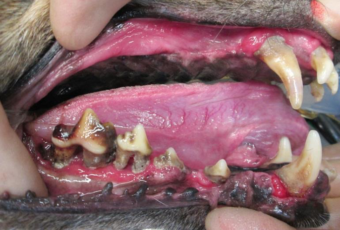
Signs
Unfortunately, most pet owners do not notice the signs of periodontal disease until it reaches a more advanced stage. In advanced stages, your dog may develop:
- Bad breath
- Problems picking up food
- Chewing on one side of the mouth
- Bleeding or red gums
- Bloody saliva or increased drooling
- Loose teeth
- Blood on chew toys
- Bumps in the mouth or below the eye
- Sneezing or nasal discharge
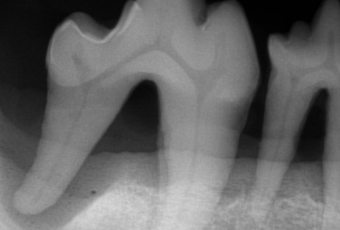
Diagnosis
Oral examination and dental radiographs (“x-rays”) done under general anesthesia are the only way to fully evaluate your dog’s oral health. Dogs should be evaluated to ensure they are good anesthetic candidates before undergoing a dental procedure. This involves a thorough physical examination, blood work, and sometimes imaging of the chest (i.e., radiographs or echocardiography).
Treatment
If caught early, a professional dental cleaning can help to delay the progression of periodontal disease. If the disease is already severe, your veterinarian may need to remove loose, painful teeth. After the teeth are removed, the remaining teeth will be thoroughly cleaned.
Following treatment, diligent home care is necessary to prevent further tooth loss.
Prevention
Brushing your dog’s teeth daily with a soft toothbrush and pet-safe toothpaste is the best way to prevent periodontal disease or to keep it from getting worse. Brushing will remove plaque and prevent dental calculus from forming. Dental treats and water additives may also be helpful, but they generally cannot be used as a substitute for brushing. These products may have enzymes that help break down plaque. For a list of recommended dental products, visit the website of the Veterinary Oral Health Council (VOHC).
Even with appropriate home care, it is still important to take your dog to the veterinarian for regular anesthetized dental examinations and cleanings.
To prevent fractures and broken teeth, avoid hard chew toys such as antlers, hooves, hard plastic toys, and bones. If you cannot use your thumbnail to make an indentation in a potential chew toy, the toy is probably too hard for your dog’s teeth.
Webinar
Many pet owners don’t realize it, but dental disease is the most common disease in dogs and cats and, if left untreated, can lead to pain, loss of teeth, and infection to major organs in the body. In this webinar, Dr. Jordan Ford, Resident Veterinarian in AMC’s Dentistry Service, discusses the most common types of dental disease in dogs and reviews the different treatment options available in veterinary medicine. Learn how to recognize oral pain and what you can do to keep your pet’s oral health in good shape! Hosted by the Usdan Institute for Animal Health Education at the Schwarzman Animal Medical Center.
Make an Appointment
